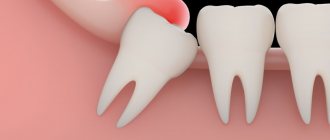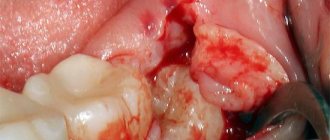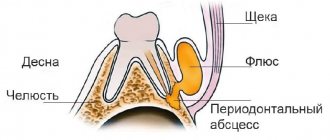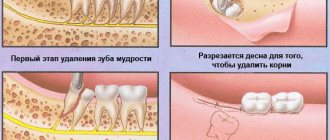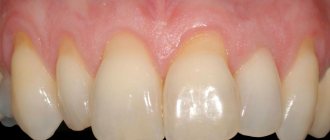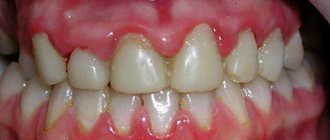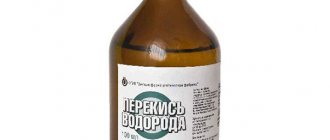Treatment of gums in children is a common reason for visiting a dentist. The susceptibility of delicate gums to inflammatory processes is explained by their sensitivity to all kinds of damage and poor hygiene. The remaining soft plaque on the teeth eventually turns into hard deposits in the form of tartar. Inflammation can also be caused by an infection that enters the oral cavity through dirty toys, for example. Unfortunately, parents are not always able to monitor the regularity and quality of brushing their children’s teeth or protect them from licking dirty surfaces.
Inflammation of the mucous membrane of the gums or gingivitis must be detected as early as possible and treatment begun. This is why regular scheduled examinations are so important. A delay in making a visit can result in a complication - there is a risk of transition to a chronic form, after which - to the ulcerative-necrotic stage, and, as a result, damage to surrounding tissues. Periodontitis is one of the most serious stages of gum disease.
Teething in infants is not only a painful process, but also provokes inflammation of the gums, as well as injuries, as a result of diligently sucking a rattle or a cracker offered by the mother...
Causes of gum inflammation in children
- Skipping or poor quality teeth brushing;
- Sucking dirty objects;
- Errors when installing seals;
- Pathologies of the dentition;
- Carious cavities with sharp edges;
- Bite correction;
- Breathing through the mouth;
- Abnormal structure of the oral cavity organs (attachment of the frenulum of the tongue and lips);
- Problems with the functioning of the cardiovascular system;
- Disruption of the gastrointestinal tract;
- Infectious diseases (ARVI, influenza);
- Hormonal abnormalities;
- Hereditary anomalies.
Types of inflammatory processes
Gingivitis
Inflammation of the gums at the initial stage, that is, not yet spreading to the bone tissue, is called gingivitis.
Treatment of gingivitis in children follows the same principle as in adults, with the only difference being that children are prescribed more gentle medications. When starting the procedure, the hygienist performs professional cleaning, removing plaque and stone, after which he teaches the little patient proper hygiene techniques. Helps you navigate the selection of toothpaste and brush.
Periodontitis
Inflammation of the gums and periodontal tissues - periodontitis - is an advanced stage of gum disease. If left untreated, its progression may result in one or more teeth having to be removed.
Treatment includes occupational hygiene and physical therapy. If the process is advanced, surgical intervention may be required.
Periodontal disease in children
The defeat of all periodontal tissues, in this case, is called childhood periodontal disease. This degree is quite rare. Progression can be triggered by weakened immunity and vitamin deficiency.
An effective option in this case is surgical intervention, as well as strengthening the general condition of the body.
Stomatitis in children
Infectious inflammation of the mucous membrane of the gums, or stomatitis, is characterized by increased sensitivity and discomfort while eating. Therefore, you should show it to a dentist as soon as possible. A dental clinic specialist will examine the baby and prescribe appropriate procedures.
Causes and symptoms of inflammation
The main reason for the appearance of gingivitis in children is the lack of proper hygiene and non-compliance with the rules of brushing teeth. Inflammation, as a rule, occurs in places that have been poorly hygienic. These are the interdental spaces of the chewing teeth.
External manifestations of gum inflammation in children can be different and depend on the causes of the disease, its course and the nature of the lesion. Often the inflammatory process occurs without symptoms, without creating any inconvenience for the child.
The occurrence of the disease in children may be indicated by:
- bad breath and a large amount of plaque;
- swelling and bleeding of the gums (mainly when brushing teeth) lasting two weeks or more.
More advanced forms are characterized by the gums acquiring a bluish tint, the appearance of periodontal itching, the appearance of ulcers, and an unpleasant taste and bad breath.
Gum atrophy
A rather unique and rare disease - gum atrophy or exposing atrophic gingivitis manifests itself as itching in the area of 2, less often 4 and 6 symmetrically located milk teeth. A child experiencing discomfort constantly rubs the area of inflammation. At night, the itching usually intensifies.
The interdental papillae and other areas of the gums do not change in any way during gingival atrophy. Slight deposits of tartar are often observed on the unprotected root surface.
The manifestation of itching can be a consequence of measles or influenza, despite the fact that in most young patients such a relationship is not observed. The process of teething is also one of the factors causing itching in infants.
Treatment of abscesses and abscesses in a child
Depending on the nature and cause of the abscess, the doctor will choose the appropriate method of treating the lump on the gum. Most often this is:
- opening and cleaning of pus;
- treatment of caries or removal of a tooth if it is severely damaged and cannot be restored.
In this case, an abscess over a baby tooth can often be eliminated only with the removal of the tooth itself. This is an undesirable process, but it may turn out that it is impossible to fix the problem in any other way.
When treating ulcers in children, the doctor is always guided by the fact that soon the milk teeth will be replaced by molars. The formation of a cyst or abscess over a baby tooth can affect the future molar, so sometimes the decision to remove a tooth is actually advisable.
After the procedure, the child is prescribed antiseptics for home use.
Diagnosis of gum disease in children
A routine oral examination should be performed by a pediatric dentist every six months. And as necessary, if a small patient exhibits any deviations in the development of teeth or symptoms of disease of the oral mucosa. Since it is advisable to diagnose the inflammatory process at the earliest stage.
If redness, swelling and bleeding are detected, the cause of which is an excessive amount of soft plaque or food debris on the teeth, the dentist will make a diagnosis and prescribe procedures.
If a bacterial infection is suspected, a clinic specialist can take biomaterial from the inflamed areas of the gums for clinical tests. Based on the results of the analysis, the specialist prescribes a treatment plan and the date of the next appointment to ensure the final recovery of the little patient.
Treatment
Therapy for this pathology must be comprehensive. It includes medication and special procedures.
For this purpose, the following methods are used:
- Treatment of all forms of gingivitis begins with getting rid of plaque. They are removed by the dentist using ultrasound, then polished using brushes and a special composition. If professional cleaning is not performed, home treatment is ineffective. As soon as it ends, the disease worsens again.
- Rinsing with antiseptic agents is used. For this purpose, solutions of Miramistin, Furacillin, Chlorhexidine and infusions of medicinal herbs (eucalyptus, chamomile, calendula, sage) are used. Rinse your mouth with them three or four times a day, after meals. Before rinsing with herbs, remove all food debris. The course of treatment lasts up to ten days.
- Lubricate the gums with gels that have anti-inflammatory properties. The following drugs are used in gel form: Cholisal, Soloseryl, Asepta (no age restrictions) and Metrogyl Denta (used in children over six years old). The drug is applied to the gums twice a day. After this, you should not eat or rinse your mouth. Drinking is not prohibited. The course of treatment lasts up to ten days.
- In severe forms, antibiotic therapy is used. The medicine is selected by the doctor individually, based on the sensitivity of the bacterial flora.
It is necessary to cure all the child’s teeth affected by caries, followed by fluoridation and silvering. Alcohol preparations are not used for treatment. They increase irritation.
Treatment of gums in children
Medicines prescribed by a doctor have analgesic, antibacterial and anti-inflammatory effects. They help restore the proper condition of the mucous membrane. Methods of using drugs are different, but the principle is the same: rinsing, irrigation.
For gum disease in infants, the dentist will prescribe special gels to relieve symptoms, namely itching and pain. Parents should pay special attention to cleaning their mouths from food debris.
Antibiotics are prescribed by a dentist in rare cases. Indications for the use of antibiotics is a form that reaches a complex (ulcerative-necrotizing gingivitis) or chronic stage. Antibacterial or antifungal drugs are prescribed when the problem is caused by an infectious process, and the goal is to eliminate its causative agent.
Types of gingivitis
The disease can progress differently, depending on the type of gingivitis. Treatment is prescribed by a doctor individually in each specific case.
Important. The acute form of the disease is much more common in children. The chronic form occurs in the absence of treatment.
Classification
The disease is classified according to several criteria:
- zone of distribution - local (one interdental papilla is inflamed) or generalized (most of the gum is inflamed) gingivitis;
- nature of the course - acute or chronic stage;
- the degree of change in the mucous membrane of the gums - catarrhal, ulcerative, hypertrophic, atrophic, marginal, desquamative.
According to the severity of the disease, three forms are distinguished - mild (damage to one or two interdental papillae), moderate (inflammation of the gum edge), severe (damage to most of the gum).
Catarrhal
Acute catarrhal gingivitis is most often diagnosed during teething or changing teeth, as well as against the background of previous infectious diseases.
Characteristic features:
- severe redness and swelling of the affected areas;
- discomfort in the gums, pain, itching, bleeding of the gums when brushing teeth or eating;
- bad breath;
- low-grade fever.
There is a feeling of malaise, but the general condition is not cause for concern.
Marginal
It usually occurs in childhood and indicates poor oral hygiene. It goes away immediately in a chronic form, another name for the disease is “dirty” gingivitis. It manifests itself in bleeding gums, usually when brushing your teeth. The marginal tissues are swollen, hyperemic, with a cyanotic tint. Treatment consists of removing plaque and following oral hygiene rules.
Desquamative
The main feature of desquamative gingivitis is epithelial sloughing. The affected areas are also distinguished by increased redness in the form of individual spots. In the initial stage, the disease does not cause concern, but later, in the absence of treatment, the mucous membrane becomes loose, pain and burning in the gums appear, and erythema spots grow. When neglected, blisters with yellowish contents appear in place of the spots, then ulcers form in place of the blisters. At the same time, sleep is disturbed, headaches and irritability appear.
Important. Desquamative gingivitis occurs cyclically with sudden exacerbation without provoking factors. Remission is long-term, up to two years.
Hypertrophic
The second name is hyperplastic. The disease is typical for prepubertal and pubertal age and is associated with the influence of sex hormones on gum tissue at this particular age. In the fibrous form, there is an overgrowth of the papillae, the gums are greatly enlarged and partially cover the teeth. The edematous form is more severe - the gums are enlarged and hyperemic. When brushing your teeth and chewing food, the pain and bleeding noticeably intensify.
A dental examination reveals severe gum overgrowth, looseness and swelling of the gingival papillae, and the presence of false gum pockets. Also, a distinctive feature of hypertrophic gingivitis is a significant amount of plaque on the teeth.
Ulcerative
The ulcerative form is the next stage of catarrhal gingivitis against the background of decreased immunity after influenza, acute respiratory viral infections, infectious diseases, and herpetic stomatitis. Another reason is hypothermia.
Characteristic symptoms:
- hyperemia, swelling, bleeding gums;
- the appearance of ulcers;
- general weakness, low-grade fever;
- bluish tint near the gums.
In the absence of adequate therapy, the disease passes into the ulcerative-necrotic stage - the ulcers are covered with a gray-green coating, a putrid odor from the mouth appears, and saliva becomes viscous. Sleep and appetite disturbances are observed, the child becomes capricious.
Atrophic
In most cases, the disease is chronic and is detected during examination by a dentist. It is observed in case of improper filling of teeth, in the presence of congenital defects of the frenulum of the tongue, or in case of malocclusion.
Symptoms – not clearly expressed:
- slight bleeding gums;
- exposure of tooth roots;
- reduction in gum volume.
In the initial stage, there are no inflammatory signs or pain, the gums are not hyperemic. Then, with the gradual exposure of the roots of the teeth, discomfort and pain appear when eating hot or cold food. In the absence of treatment, progressive dystrophic changes in the gingival margin are observed.
Preventive actions
The best prevention of inflammation of the mucous membrane is daily and high-quality hygiene from an early age and proper nutrition.
Hygiene
The concept of “quality hygiene” includes brushing your teeth at least twice: in the morning and in the evening, in conjunction with cleaning the palate and tongue.
Parents should take a very responsible approach to hygiene from the day the first tooth appears. And after he grows up a little, learn the rules of brushing his teeth: regularly and efficiently. The toothbrush and toothpaste should be selected according to the age of the small patient.
Nutrition
In addition to hygiene, parents need to approach the diet wisely: it should be balanced and include vitamins and minerals. Sweets and carbonated drinks should be consumed by the child in limited quantities. In addition, after finishing eating sweets, the baby should rinse his mouth with water and, if possible, brush his teeth. Note that a diet that promotes the proper development of a growing body includes nutritious and timely meals. Snacking and disordered eating should be kept to a minimum.
Swollen gums in a child
If your child has become capricious, lethargic, has a fever and complains of pain in the mouth, it may be gumboil. The scientific name for this phenomenon is periostitis. The disease is associated with inflammation of the tissues of the periosteum of the alveolar processes. It is caused by a decrease in immunity and the proliferation of pathogenic bacteria with the formation of pus.
Symptoms:
- weakness, painful condition;
- increased body temperature;
- possible refusal to eat;
- redness of the gums in one place, swelling;
- swelling of the cheeks/lips, asymmetrical face in a child.
What to do? Take your child to the dentist as soon as possible.
In this case, you don’t need to make an appointment in advance - you will see a doctor with the wording “for acute pain.” The specialist will open the tooth and rinse the canal, and in the future you will have to make sure that the child rinses his mouth with an antiseptic solution. It is also possible for a doctor to prescribe antibiotics.
The dentist will also recommend making an appointment with him after the inflammation has subsided. It is necessary to put a filling on the tooth, since the open canal will periodically become inflamed, and it is undesirable to leave it like that.
Treatment of children at RAIDEN
In the RAIDEN network of dental clinics, the treatment and prevention of oral diseases of young patients is treated with the utmost attention and reverence - the health of the younger generation is very important to us!
All medications used in our clinic meet the highest quality requirements. Before using them, we conduct a blood test of the baby to determine drug tolerance. The safety of your children, our little patients, is paramount to us.
What does a fistula on the gum look like?
It is possible that the inflammation will not be so acute, and the result will be a breakthrough of pus into the oral cavity - a fistula on the gum that looks like a lump or an abscess in a child.
Symptoms:
- possible complaints of pain in the mouth;
- body temperature is often within normal limits;
- redness of a small area of the gum;
- fistula in the gum area - looks like a light or yellow lump due to the accumulation of pus.
What to do? The situation does not require immediate consultation with a doctor, but it is necessary to see him at least within 1-2 days, since a fistula is also evidence of an inflammatory process. Don't delay visiting the dentist. The fact that the fistula has broken through does not mean that the inflammatory process has stopped. The doctor must clean the canal and prescribe adequate treatment.
Please note that the child may not complain of pain in the mouth. You may not track the onset of the disease, but detect the fistula already at the healing stage. Even if this is the case, it’s worth seeing a doctor - he will determine the reason why the canal became inflamed and recommend what measures to take to prevent this from happening again.
Causes of an abscess on the gums of a child
Flux or fistula with the release of pus always indicates an inflammatory process. The reasons may be:
- Periodontitis is a complication of caries in which the tissues surrounding the tooth become inflamed. At the same time, granular red tissue grows, which can replace healthy gum cells. In childhood, a tendency to periodontitis is observed more often. Inflammation can begin due to viral infections, stress, and hypothermia. This is the most common reason for the formation of fistulas on the gums or gumboils in children.
- Odontogenic osteomyelitis is an inflammation of the tissues of the jaw bones. In children it develops especially quickly and is accompanied by high body temperature.
- A cyst in the tooth area is a painless formation, which is a capsule filled with liquid. Occurs due to disturbances in the development or eruption of teeth, if they are not treated correctly. A fistula forms when the cyst becomes inflamed, producing pus, and the pus ruptures.
- Odontogenic sinusitis is inflammation of the sinuses of the upper jaw due to dental diseases. It may also be accompanied by the formation of fistulas.
- Errors in dental treatment, for example, incomplete filling. In this case, an infection enters the canal, which causes inflammation and, as a result, the eruption of pus in the form of fistulas.
- Retention of teeth, i.e. impossibility of cutting through them. It is observed when breasts are removed too early. This condition is extremely rare and is usually associated with systemic disorders in the body, for example, rickets.
- Injuries to the tooth or gums, at the site of which inflammation may begin.
Treatment of gumboil or fistula in a child
Treatment of fistula directly depends on the cause of the disease. It is comprehensive and includes a number of measures to relieve inflammation and prevent new infections:
- Therapeutic measures include removing the filling, opening the canal, cleaning it and disinfecting it. The doctor may leave the canal open or place a temporary filling. He will also recommend applying for a permanent filling. These measures are justified if the tooth is permanent.
- If inflammation of the canal is observed in a baby tooth, the doctor will also open it and clean it. However, in some cases, he may recommend tooth extraction, since in the future inflammation can be recurrent, that is, periodic.
- Drug therapy. The dentist will prescribe antibiotics and also advise which solution is best to rinse the mouth. In some cases, doctors also prescribe antihistamines.
That is, a visit to the dentist if you find an abscess or lump on your child’s gum is mandatory. The inflammation will not go away on its own, it can only spread to other tissues - to the area of the buds of permanent teeth. Which will make the situation worse and may affect permanent teeth.
Home treatment for gumboil and fistula in a child
After the canal is cleared, the doctor will send you home. At home, you need to ensure that your child regularly rinses his mouth with antiseptic solutions. Rinsing reduces inflammation and helps clear the open canal of pus.
The doctor will determine which solutions are suitable for your child. He may also prescribe antibiotics if he thinks the inflammation is severe enough. Do not give your child medications unless prescribed by a specialist.
Is it possible to use traditional methods of treatment for fistulas and inflammations? In principle, herbal decoctions also have a wound-healing and slight antiseptic effect. However, it is better to also talk to your doctor about using them. Knowing the nuances of your situation, he will recommend the optimal remedy - effective and safe for your child.

